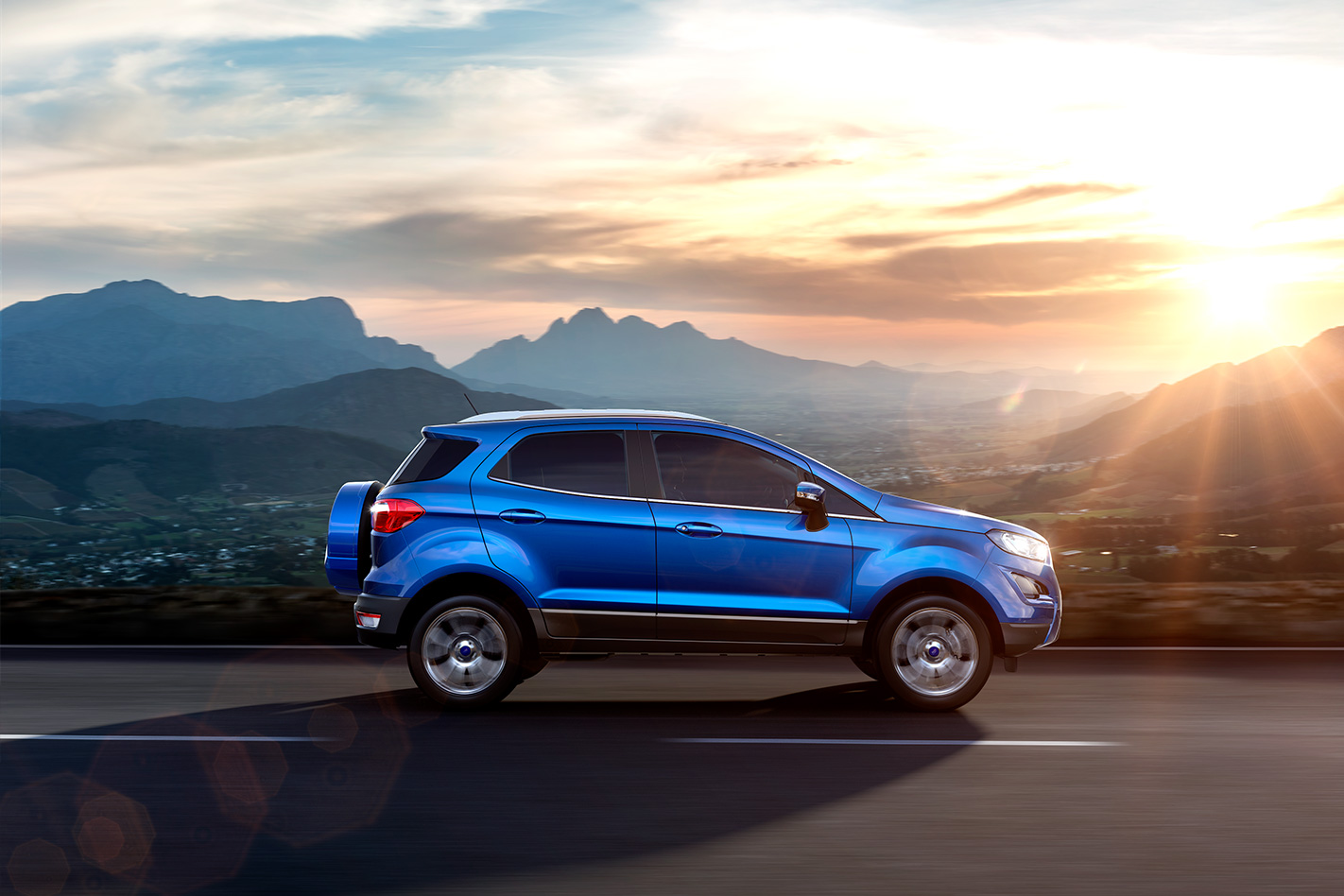
The Ford EcoSport, a small SUV that kicks around in the same off-road-styled sandpit as the Holden Trax, Mazda CX-3 and the Nissan Juke, has received its most significant update since its launch here in 2013.
Despite the changes, the price of the entry-level Ambiente remains at $20,790 so as to not frighten off city-friendly SUV buyers on a tight budget. But opt for one of the more richly equipped models and you’ll have to dig deeper than before; the volume-selling Trend is up $2200 to $24,490, and the range-topping, sunroof- and leather-trimmed Titanium rises by $1200 to start from $28,990.
Visually, the EcoSport gains a number of changes that vastly improve the looks over the old model. Key to this is a new fascia that ties the EcoSport in more closely with the other “E” SUVs in the Ford line-up – the Escape and Everest (and the soon-to-arrive Territory five-seater replacement, the Endura).

That includes a new bonnet with an, ahem, power bulge, and foglights that add definition to what was, and let’s be honest here, a distinctly unremarkable look of the car it replaces. Down the rear, a restyled bumper and more modern-look tail-lights that on the right-hand side hide the soft-touch release for the swinging tailgate add a different look.
The EcoSport range kicks off with the Ambiente. It uses a new generation of Ford’s 1.5-litre three-cylinder engine that produces 90kW and 150Nm, a gain of 8kW and 10Nm over the engine it replaces. The other big change, though, is that this, and all other engines in the EcoSport line-up, adopt a new six-speed automatic transmission.
Inside, the cloth-trimmed EcoSport has had another big makeover that improves it well beyond the old car’s Ford Fiesta-like fit-out. There’s now a redesigned steering wheel and centre armrest between the re-cut front seats – plastic until you spend a bit more to step up to the Trend – and two backlit USB ports that indicate the arrival of Sync 3, the latest version of Ford’s multimedia interface, to the small SUV range.
A small tray slides out from under the front passenger seat, a good option given there’s no cover over the centre console’s bulkhead storage spaces.

There’s a different instrument cluster with a sharp-looking digital display that includes the tripmeter and a digital speedo. The cruise control system includes a speed limiter. The dashboard is much cleaner, with a tombstone-style 6.5-inch multimedia touchscreen replacing a number of buttons in the pre-facelift car and linking to a reversing camera with reverse parking sensors.
The driver’s seat features six-way manual adjustment, and the front passenger seat four-way as it misses out on height adjustment. You need a key to start the engine, but at least the doors open remotely via the key fob. Once inside, the driver’s window has automatic up/down.
There’s one 12-volt charging point for the front seats, and another tucked away in a small storage space on the outboard side of the right rear seat. Down the back, the EcoSport’s rear seats flip and tumble forward to provide a flat floor, increasing load space from 743L to 1178L, and the boot floor has three settings that, on its highest, provides an under-floor storage space.

The EcoSport Ambiente sits on 16-inch steel wheels featuring plastic hubcaps. A full-size spare wrapped in the same 205/30 profile Goodyear Assurance rubber hangs off the tailgate. Black highlights – the grille, mirror caps and door handles – mark the entry-level status.
Each EcoSport also has Ford’s capless fueling system that doesn’t require owners to unscrew a cap before refuelling.
The mid-spec Trend is expected to remain as the EcoSport’s best-selling model. It replaces the 1.5-litre engine in the Ambiente with a turbocharged 1.0-litre three-cylinder engine producing 92kW/170Nm, up 10kW/30Nm over the pre-facelift car.
Externally, it swaps out the Ambiente’s 16-inch steel wheels to alloys, keeping the same rubber. It adds fog lights to the front bumper, and a silver grille. The mirror caps and door handles, meanwhile, become body-coloured and the roof rails are finished in a matte black.
Inside, the noticeable change is the multimedia touchscreen, which steps up to 8.0 inches, adds satellite navigation, and has seven speakers, three more than the entry-level variant. The steering wheel replaces the plastic for leather, and in the back seat there’s a fold-down armrest with a pair of cupholders.

The range-topping Titanium adds leather trim to the seats and a sunroof. Keyless entry and push-button start mean you can keep the key stowed away when entering and firing up the engine. The air-con system adds climate control – using 1980s-style LED indicators to show the temperature setting – while an auto-dimming rear vision mirror, folding side mirrors, and a sliding armrest are also standard.
The wheels step up to 17-inch alloys wrapped in fuel-miserly 205/50 profile Bridgestone Ecopia tyres. The spare wheel adds a cover. The grille, framed in LED daytime running lights, gains a chrome look, the halogen headlights of the other models are replaced with high-intensity discharge lamps. The folding mirrors add puddle lamps, and the roof rails are finished in silver.
The Titanium is also the richest model in terms of driver assistance, adding front parking sensors, a blind spot monitor, dusk-sensing headlamps and rain-sensing wipers.
One thing the EcoSport range lacks, though, is emergency autonomous braking, a feature that any new – rather than facelifted – car would need to get a five-star crash rating. Instead, the EcoSport is expected to carry a five-star crash test rating that it was awarded five years ago.



